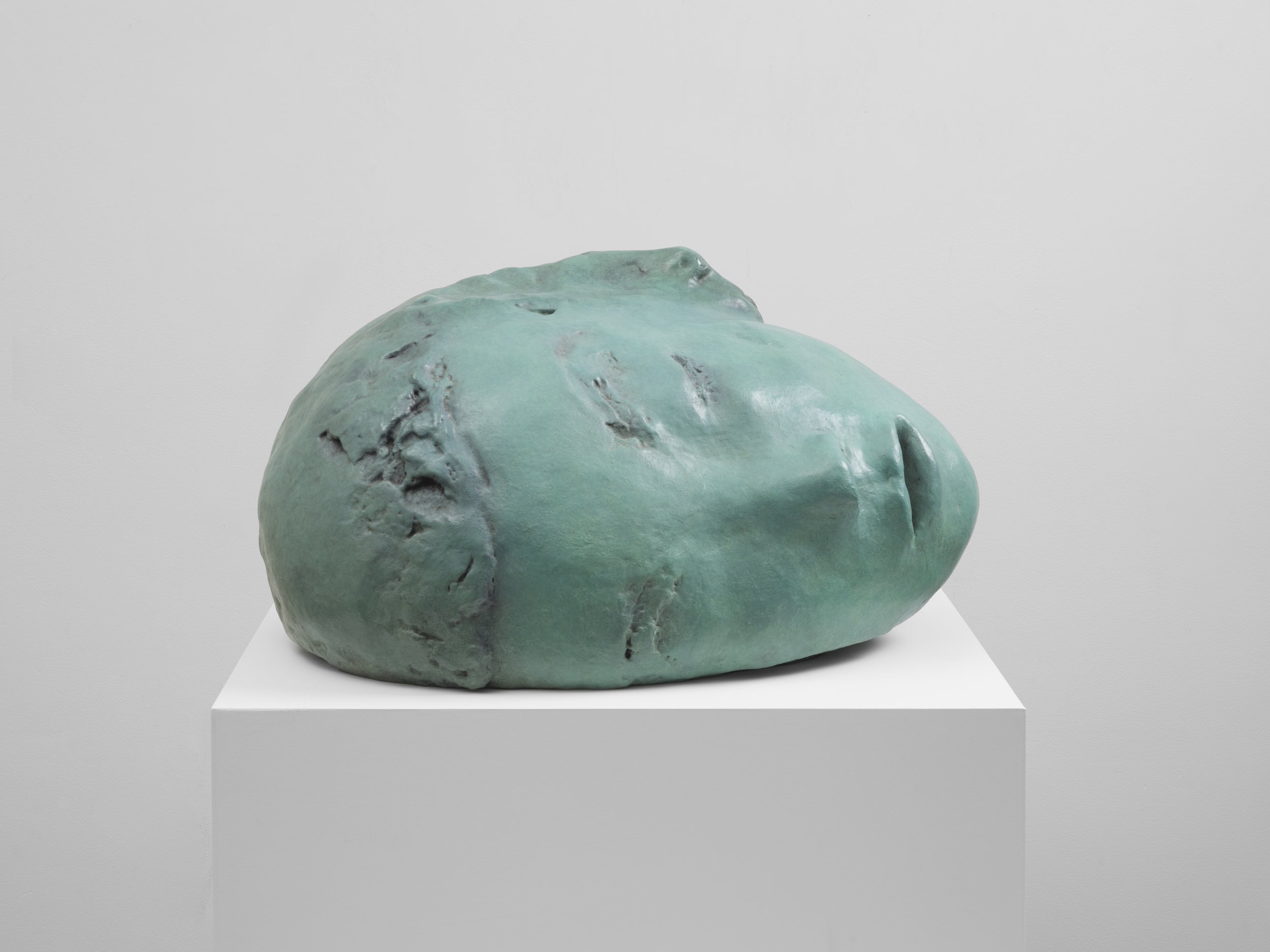Leiko Ikemura: Talk to the sky, seeking light
Exhibition view of ‘Leiko Ikemura: Talk to the sky, seeking light’ at Lisson Gallery, New York, 1 May – 1 August 2025 © Leiko Ikemura, Courtesy Lisson Gallery
“The uncertainty of our time brings many questions, but also possibilities. The female figures initiate new life, holding it in their arms and in their body as a part of themselves”
Leiko Ikemura Genesis, 2015 Tempera on jute 190.2 x 290.2 x 6.4 cm 74 7/8 x 114 1/4 x 2 1/2 in © Leiko Ikemura, Courtesy Lisson Gallery
Lisson is pleased to host Leiko Ikemura’s first exhibition with the gallery, featuring many of the themes present in her work over the past 30 years, including a wide range of media from paintings in tempera to bronze figures and glass forms. The installation revolves around a central, three-and-a-half metre rabbit/woman figure, known as Usagi Janus (2025). This hand-sculpted and hand-patinated, protective spirit – part-bunny, part-bodhisattva of compassion – provides respite from the outside world in her conical-shaped bodily enclosure, the tiny punctures in her mothering skirt creating an internal universe of projected stars. The giant’s two faces – one staring forward, the other looking backwards – refer to the many alter egos and avatars that appear throughout Ikemura’s oeuvre, some of which can be seen in the smaller bronze pieces and crystal heads. The Janus-faced figure represents less of an either/or dialectic than a it does state of in-betweenness, one she seeks to explore through her anthropomorphic creatures and objects, or else in the spaces that dwell neither in light nor dark, neither in good nor evil, but rather in a twilit dusk and a zone of uncertainty.
Leiko Ikemura Sleep, 2010/2024 Patinated bronze 41.9 x 79.1 x 52.4 cm 16 1/2 x 31 1/8 x 20 5/8 in © Leiko Ikemura, Courtesy Lisson Gallery
The Usagi is a recurring motif that Ikemura recalls from a childhood game to locate the shadowy features of a rabbit on the surface of the moon, but first appeared as a character in her practice following the Tōhoku earthquake and associated Fukushima nuclear accident of 2011. Witnessing reports from afar of devastation for both the Japanese population and its natural habitats, including subsequent birth defects in animals, the artist envisaged this mythical Usagi acting both as a messenger for the kami (gods) and as a container for universal suffering, resilience and renewal. A precursor can be seen in a smaller-scale bronze from 1990, titled Hasen-Frau or Hare-Woman, revealing how Ikemura’s creatures have endured and survived many decades, while the German title points to the decision, relatively early on in her career, to settle and make work in Europe.
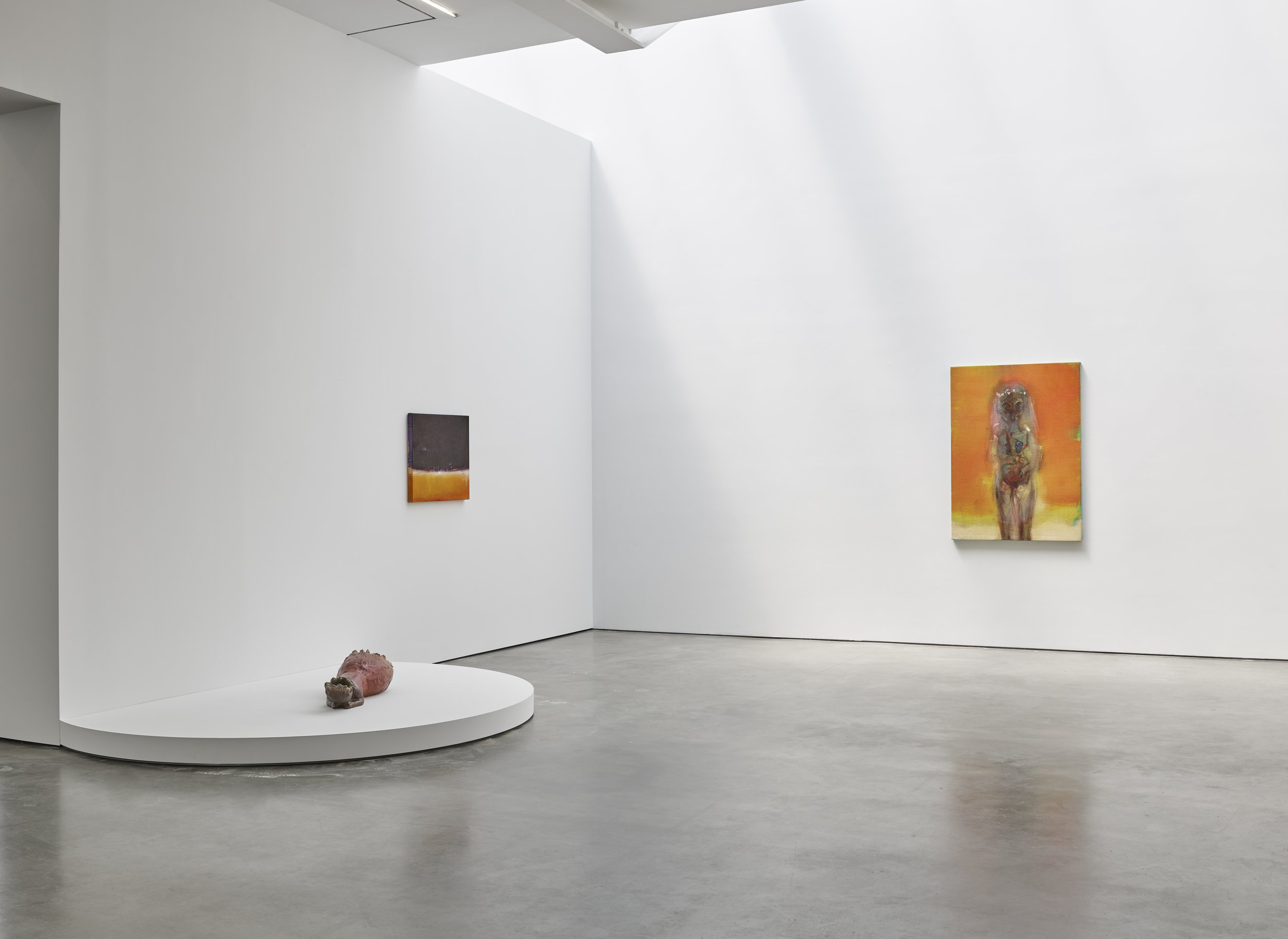


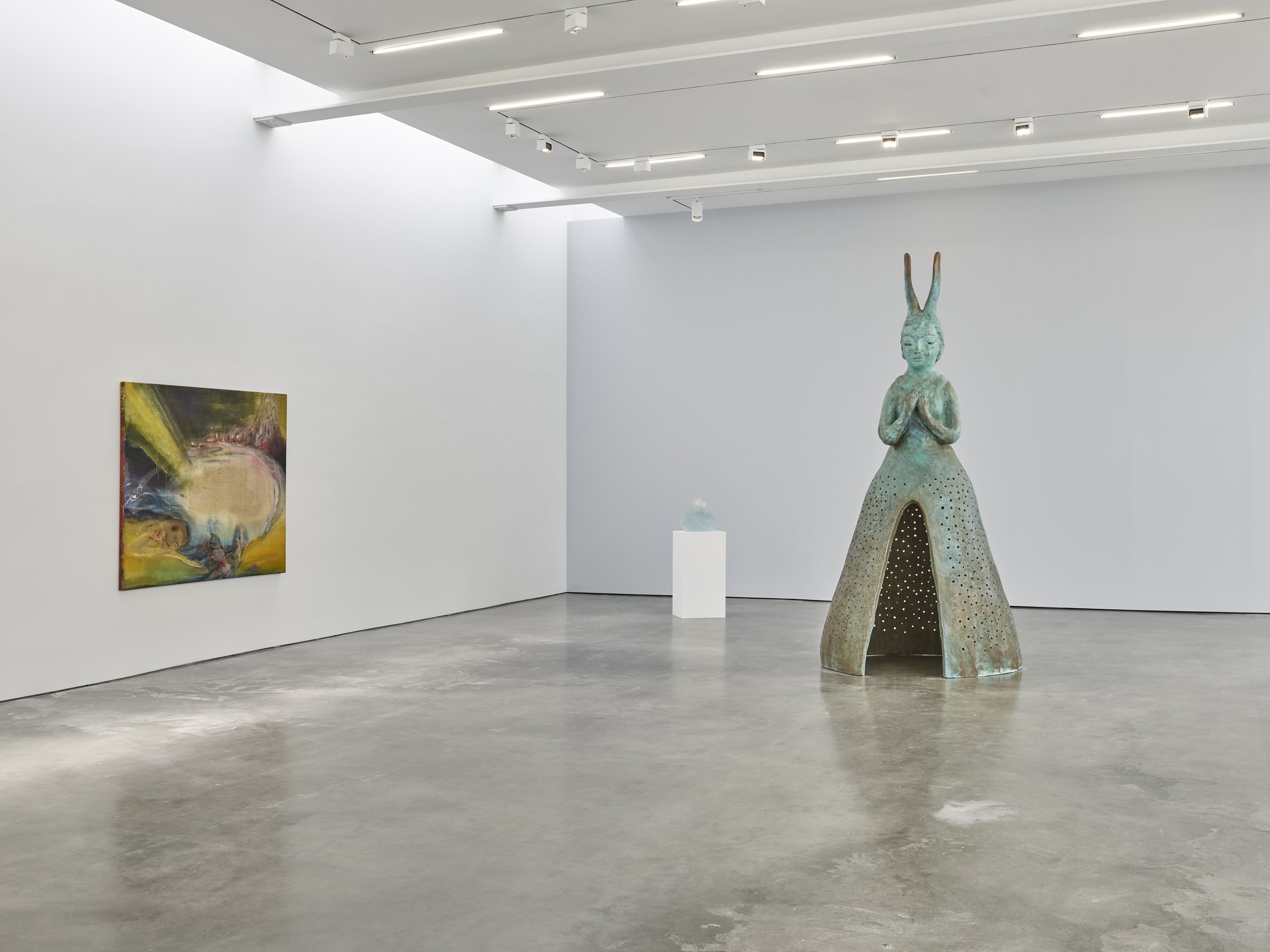
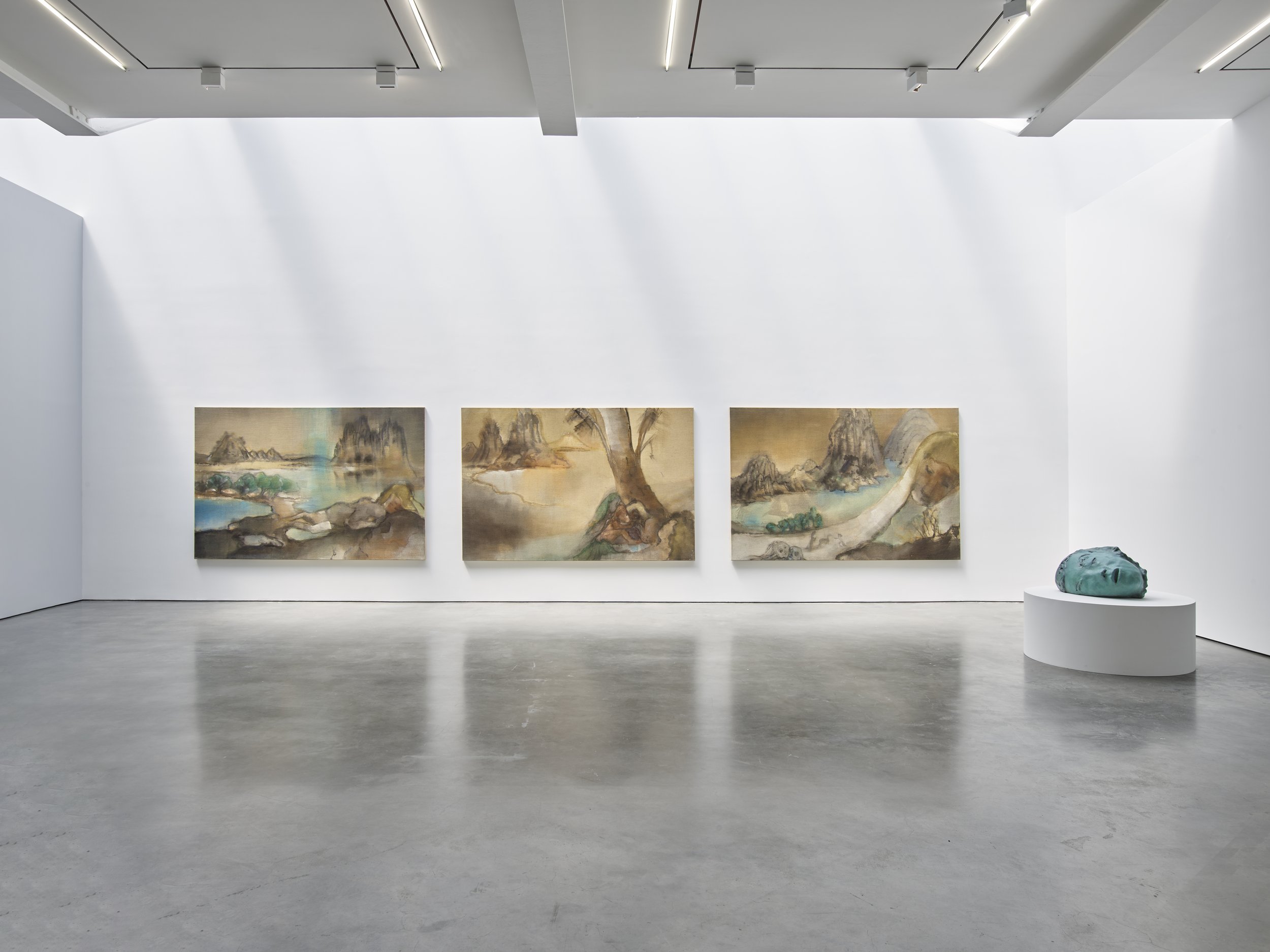
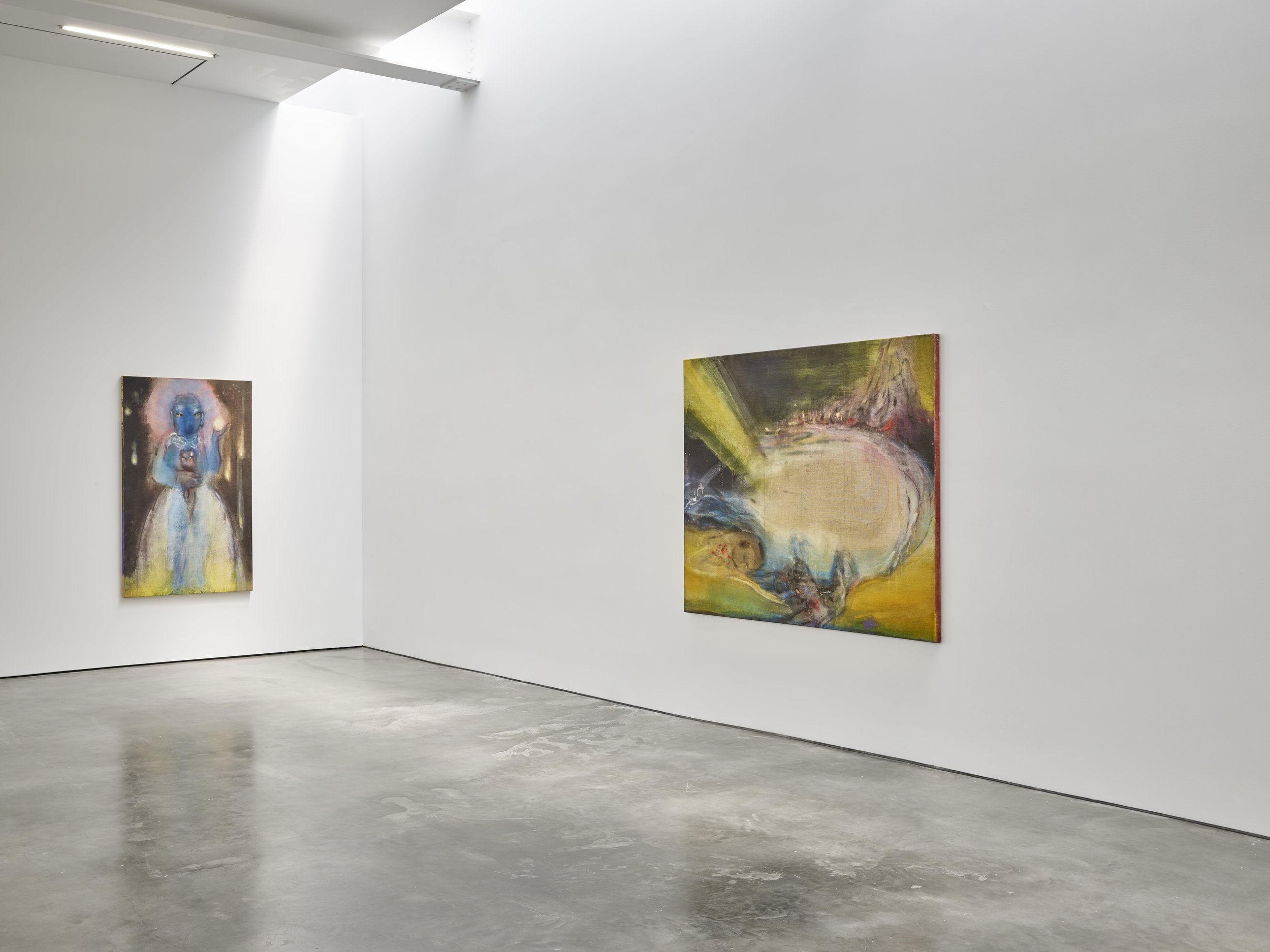
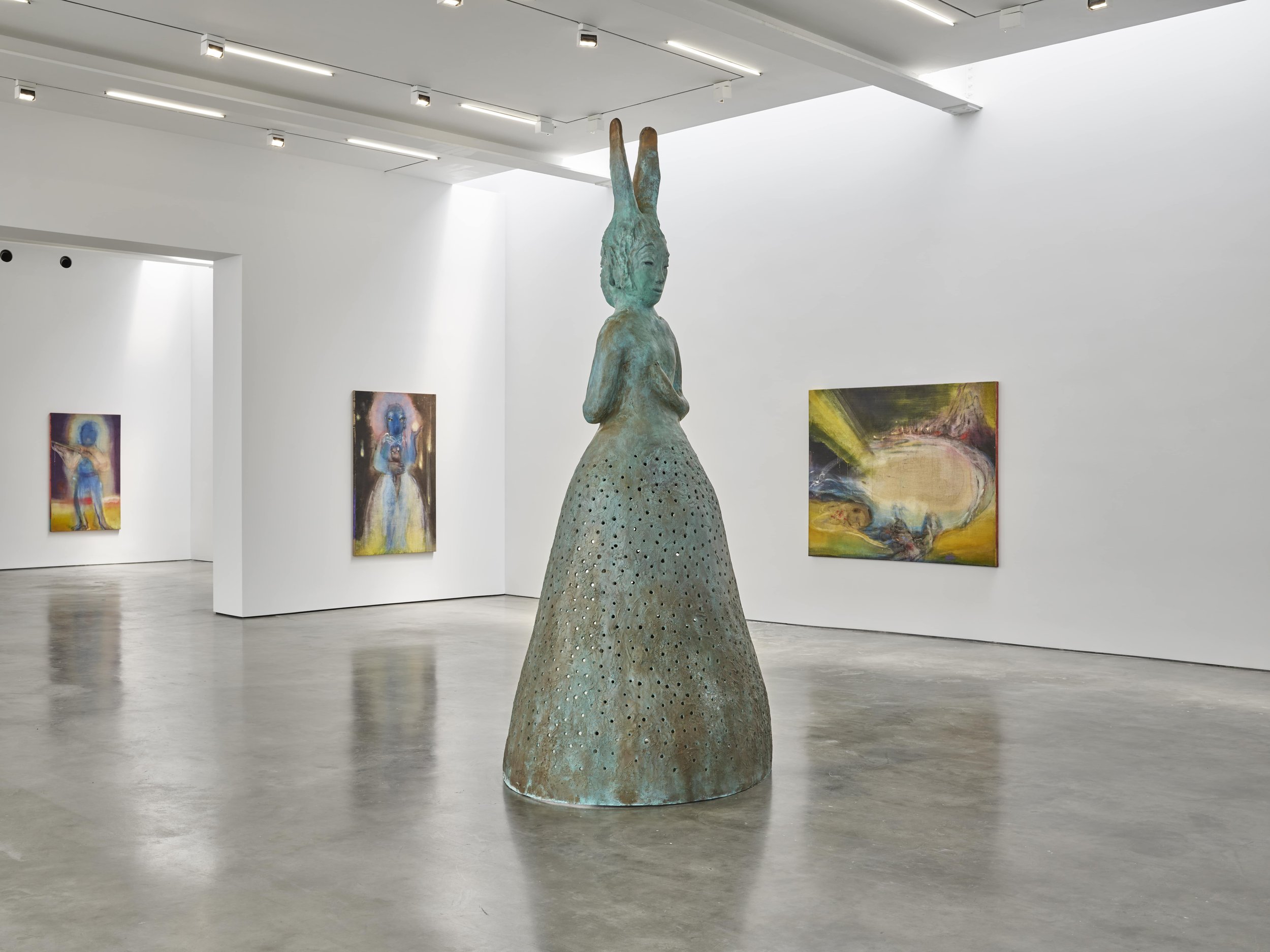
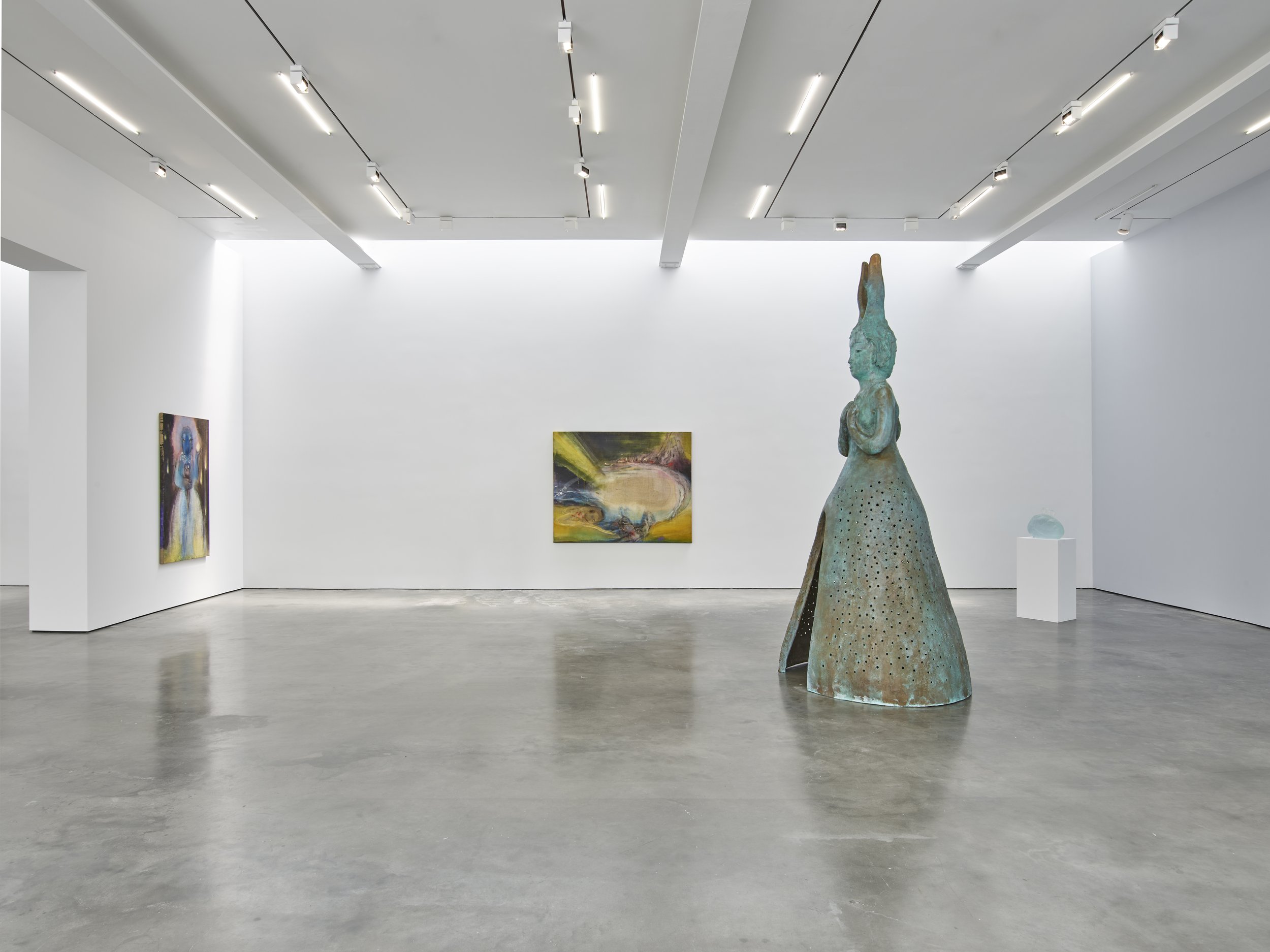
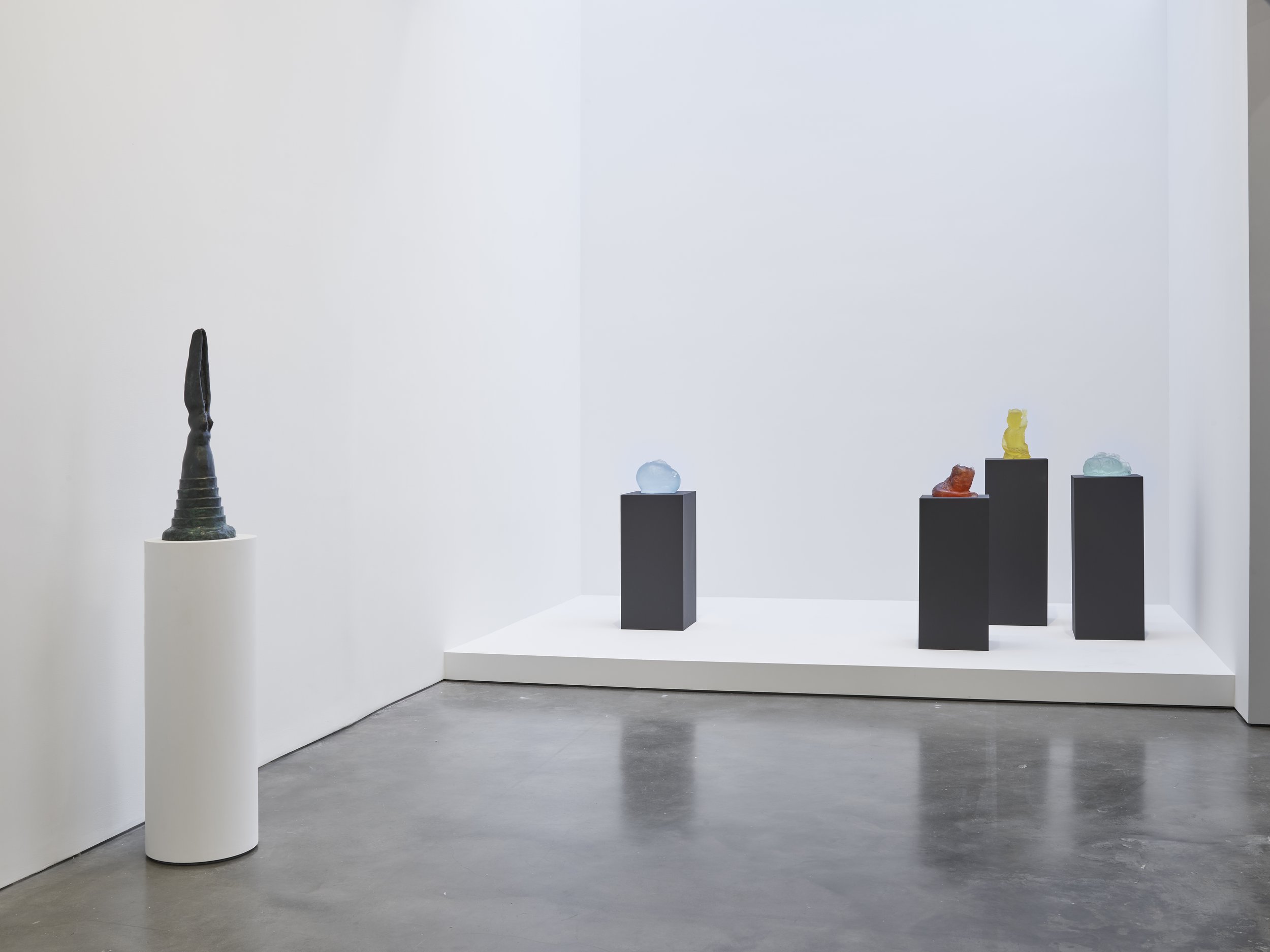
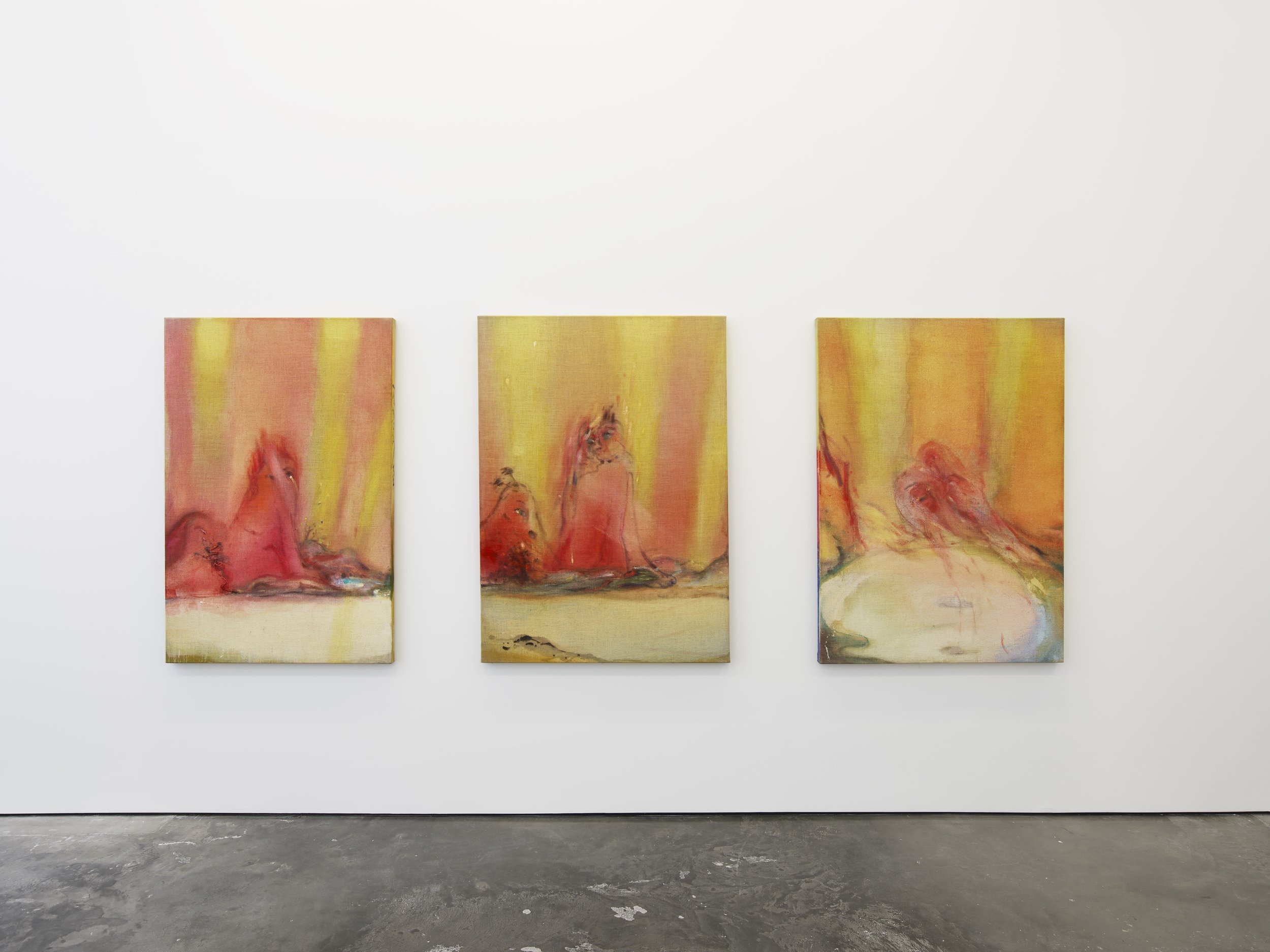
Exhibition view of ‘Leiko Ikemura: Talk to the sky, seeking light’ at Lisson Gallery, New York, 1 May – 1 August 2025 © Leiko Ikemura, Courtesy Lisson Gallery
Framing the shrine-like form of Usagi Janus is a trio of fantastical landscapes depicting a bucolic, forest scene, which might also depict the very origins of life on our planet. Among the mountainsides and wooded pastures are reclining figures or hidden faces, either fused indelibly with the land or haunting its borders through skeletal or skull-like apparitions. In one of Ikemura’s poems, entitled Transfiguration, she writes: “I’ve seen it / everything changes / people turn into rocks / into mountains / into oceans.” A figure in repose is also captured vividly in Sleeping Figure in Red (1997/2012), in which a young female is face down, with head in hands, perhaps in distress or, as the title suggests, at rest.
Ikemura’s recurring cast of young girls can be found variously recumbent, strident, floating, crying, laughing. Here a duo of Brave Girls(2022), one in pink with a cat, one in orange with a wedding veil, flank a third, Pièta in Cherry Red (2024), also cradling a cat or baby, with a pair of hypnotizing eyes blazing back at the viewer. At once powerful and confrontational, but also vulnerable and naive, Ikemura again finds a subtler path between these extremes for her fearsome adolescents, the pigments soaking through and infusing the raw jute canvas with their glowing, glowering presence. Whether as psychological portraits of moods or alternate, hybrid beings, these singular objects by Ikemura amount to an impressive act of world building and longevity.
Leiko Ikemura Cat, 2020 Cast glass 20 x 27 x 17 cm 7 7/8 x 10 5/8 x 6 3/4 in © Leiko Ikemura, Courtesy Lisson Gallery
About the artist
Since the 1980s, Leiko Ikemura has explored themes of transition, cross-culturalism, collective responsibility, and sexuality, emancipating the feminine body from its position in history and mainstream contemporary culture by challenging artistic conventions and disrupting social norms. The internationally recognized artist seamlessly shifts between luminous, otherworldly and often monumental oil paintings, introspective drawings and watercolours, glazed terracotta sculptures, glass and ceramics.
Focusing on the transient innocence of childhood, Ikemura’s female spirits are defiant and independent, yet fragile and ethereal, almost ghost-like, bestowing the spirits with a composite power to exist within multiple worlds, between dreaming and waking states. Fusing Eastern and Western art – conceiving a realm inspired by East Asian sansuiga painting traditions, old Japanese masters, surrealism, post-war abstraction, and the revival of figurative painting in the 1980s – Ikemura’s spiritual works are imbued with a raw and tender presence that highlights the intimate relationship between human, animal, plant, mineral forms, and cosmology.
Leiko Ikemura (イケムラレイコ, 池村 玲子, Ikemura Reiko) was born in Tsu, Mie Prefecture, Japan and is based in Berlin. She studied at the Osaka University of Foreign Studies from 1970–1972, followed by the Escuela Superior de Bellas Artes de Santa Isabel de Hungría, Seville, Spain from 1973–1978. In 1979, Ikemura moved to Zurich to pursue a career as an artist. In 1991, Ikemura became a professor of painting at the Universität der Künste in Berlin. Since 2014, she has held a professorship at the Joshibi University of Art and Design near Tokyo.
A major survey exhibition by Leiko Ikemura, ‘Motherscapes’, takes place at the Albertina, Vienna, Austria November 21 – February 8, 2026. She has exhibited in numerous solo exhibitions internationally, including Kunsthalle Emden, Germany (2024-25) HEREDIUM in South Korea (2024), Georg Kolbe Museum Berlin (2023), Feuerle Collection, Berlin (2023), Museum de Fundatie, Zwolle, Netherlands (2023), Museo de Arte de Zapopan, Guadalajara, Mexico (2023), Being Art Museum, Shanghai (2023), Museum für Asiatische Kunst, Berlin (2022 & 2012), Sainsbury Centre for Visual Arts, Norwich (2021), CAC La Ciutat de les Arts i les Ciències Valencia (2021), Stiftung St. Matthäus, Berlin (2020), The National Art Center, Tokyo (2019), Kunstmuseum Basel (2019 & 1987), and Nordiska Akvarellmuseet Skarhamn (2019).
About Lisson Gallery
Lisson Gallery is one of the most influential and longest-running international contemporary art galleries in the world. Today the gallery supports and promotes the work of more than 70 international artists across spaces in London, New York, Los Angeles, Shanghai and Beijing. Established in 1967 by Nicholas Logsdail, Lisson Gallery pioneered the early careers of important Minimal and Conceptual artists such as Art & Language, Carl Andre, Daniel Buren, Donald Judd, John Latham, Sol LeWitt, Richard Long and Robert Ryman among many others. It still works with many of these artists and others of that generation, from Carmen Herrera and Olga de Amaral to Hélio Oiticica and Lee Ufan. In its second decade the gallery introduced significant British sculptors to the public for the first time, including Tony Cragg, Richard Deacon, Anish Kapoor, Shirazeh Houshiary and Julian Opie. Since 2000, the gallery has gone on to represent many more leading international artists such as Marina Abramović, Ai Weiwei, John Akomfrah, Liu Xiaodong, Otobong Nkanga, Pedro Reyes, Sean Scully, Hiroshi Sugimoto and Wael Shawky. It is also responsible for raising the international profile of a younger generation of artists including Dana Awartani, Cory Arcangel, Garrett Bradley, Ryan Gander, Josh Kline, Hugh Hayden, Haroon Mirza, Laure Prouvost and Cheyney Thompson.
The exhibition opened on May 1 and will be on view until August 1, 2025, at the NYC location at 508 West 24th Street. For more information about this exhibition and others, please visit the Lisson Gallery here. The gallery can also be found on Facebook, YouTube, and Instagram.


